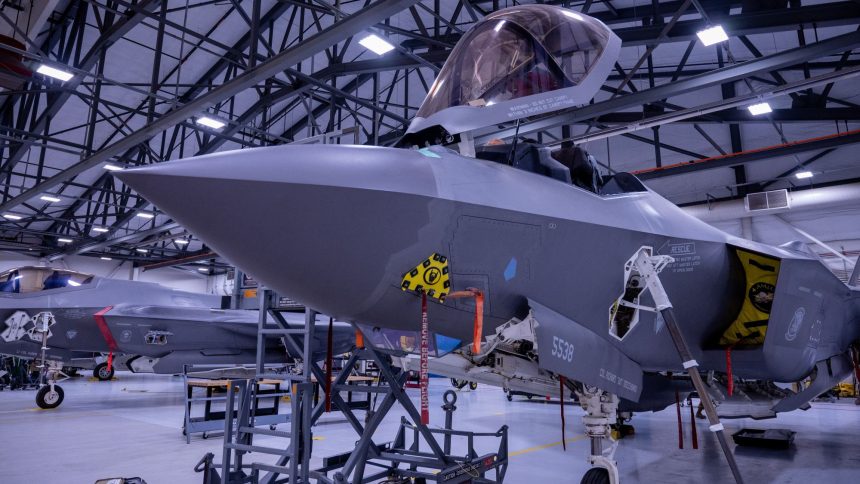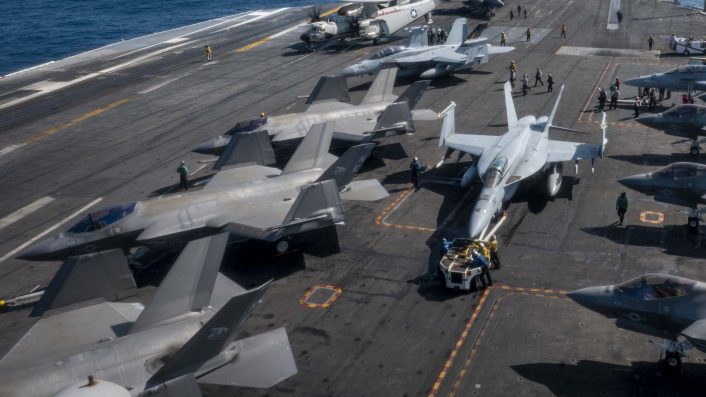While wear, tear and environmental impacts on the cockpit’s canopy glass don’t affect airworthiness, it impacts the aircraft’s low observable and stealth features.
U.S. Air Force F-35As of the 388th Fighter Wing (FW) at Hill AFB (Air Force Base) received “new, more durable canopies.” According to images and information released on the DVIDS network on Apr. 10, 2025, maintainers installed the improved canopies that “reduce the need for field repairs.”
The captions pointed to the “outer surface of the canopy,” which directly contributes to the F-35’s low observability. The degradation of the canopy’s surface “can lead to lower aircraft availability,” explained the service.
The current work brings to the fore the critical and technically complex LO (Low Observability) and RAM (Radar Absorbent Material) coating maintenance on stealth jets like the F-35 Lightning II, F-22 Raptor and B-2 Spirit, which The Aviationist has reported in the past. While the special paints, tiles and coatings themselves do not impact airworthiness or combat capability, their degradation makes the aircraft visible to enemy radars.
The images show at least two F-35As of the 388th FW in a hangar, with their integrated telescopic ladders extended, possibly after the installation of the new canopies. We can assume all the fighters in the unit are progressively receiving the upgrade, although the Air Force did not provide further details.
The accompanying caption in the photograph did say that “maintainers have the capability to make canopy repairs virtually anywhere.” In fact, should the canopy’s surface be damaged while the aircraft is deployed operationally, maintainers need to be able to quickly restore it to its original condition to preserve the LO.
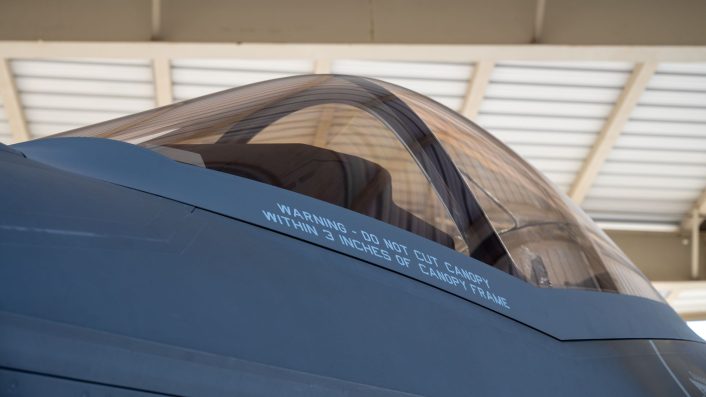
F-35 canopy
Interestingly, in 2019, the F-35’s canopy figured as one of the major issues, among other systems, in former Secretary of Defense Mark Esper’s written answers to the Senate Armed Services Committee. As can be seen in the latest images on DVIDS, the new canopies show a certain ‘shine’ on the surface, which could be due to new materials used during the lamination process of the material.
This might be traced back to 2019 when Breaking Defense reported a “delamination” effect on the F-35’s canopy in its interview with F-35 program manager Brandi Schiff, after Esper’s submissions. Schiff said in her response:
“The primary source of unserviceable canopies is transparency coating delamination. Delamination occurs when the surface coatings on the canopy separate from the base transparency. Though this condition occurs through normal use, several transparencies have delaminated unexpectedly after only a couple hundred flight hours of use. This issue does not impact the airworthiness of the canopy or aircraft.”
At the time, a joint team made by Lockheed Martin, its subcontractor GKN Aerospace, and the F-35 Joint Program Office identified the “root cause/s of early delaminations,” as “a change to the sealant between the transparency and the aircraft frame introduced in 2015 as a cost saving measure, which can be corrected by reverting to the previously used sealant.”
An F-35 with a sun screen for it’s cockpit.#aviation pic.twitter.com/XUttu72yGi
— ƬЯIDΣПƬ (@terrraform) April 14, 2025
Canopies then began getting “delivered with the correct sealant,” and the number of “early delaminations” was expected to decrease. “The correction will be verified after modified canopies have been delivered to the fleet and achieved several hundred flight hours without delamination,” Schiff added in her response to Breaking Defense.
They also identified another supplier, PPG Aerospace, to “repair damaged transparencies from the fleet” and return them “as replacement canopies,” to “greatly improve spares availability” and “have a positive effect on F-35 mission capability status.” Additionally, the government was also in the “final stages of qualifying PPG to produce new transparencies in addition to the company’s current repair capability.”
Schiff further mentioned that all necessary contracts were already in place and testing of the specifications and ejection seat compatibility was in progress to support the production of new transparencies from PPG. Testing was “expected to run through the first quarter of 2020,” while deliveries were “expected to begin early second quarter of 2020.”
Transparencies is the technical term used to refer to aircraft windshields, canopies, windows, electrochromic panels and lenses. PPG Aerospace’s website lists a variety of leading aerial platforms using its products, including the A-10 Warthog, A400M Atlas, AH-1 Cobra, AH-64 Apache, B-2 Spirit, B-52 Stratofortress, Bell 360 Invictus, C-130 Hercules, C-17 Globemaster, C-27J Spartan, C-5 Galaxy, F-22 Raptor, CH-47 Chinook and, lastly, the F-35 Lightning II. For the F-35, it doesn’t specify the type of product, and it is therefore not clear if the new canopies installed on the 388th FW’s F-35As at Hill AFB are from PPG Aerospace.
In-house innovations
The 33rd FW at Eglin AFB, Florida, also publicized in Dec. 2023 their own canopy cover and reusable wash covers for the F-35. The covers were developed by the 33rd Maintenance Group’s (MXG) maintainers Tech. Sgt Andrew McCamish, 58th Aircraft Maintenance Unit aircraft section chief, and Staff Sgt. Tyler Schmitt, 33rd MXG quality assurance inspector, who adopted AFWERX’s (Air Force Works) Portable Magnetic Aircraft Cover (PMAC) originally developed for the F-22 raptor.
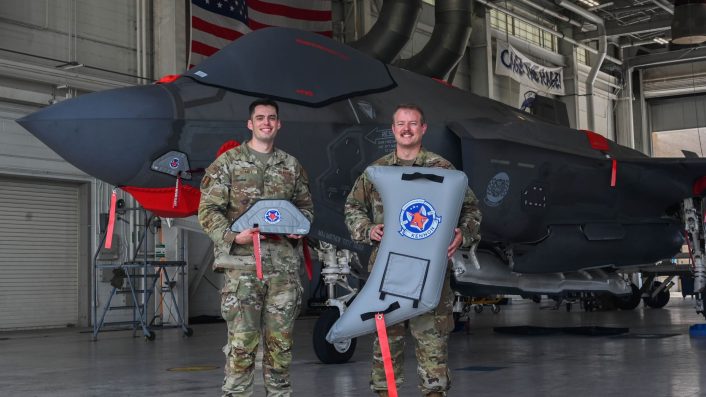
Meant to protect the canopy from “environmental and maintenance damages,” the cover performed “flawlessly” in a test against 70 miles/hour winds, validating that it could reduce “foreign object hazard while still protecting the canopy’s coating.” The “lightweight, reusable and storable” canopy cover, that can also be used in deployment in forward bases, saves maintainers time and increases sorties for the aircraft.
The new reusable wash cover offered cost-savings of $15,000 to $20,000 annually on consumables like “barrier paper,” used to tape the aircraft after washes, with the wash time itself reduced to 10 minutes from an hour. At the time, the team was coordinating with the F-35 JPO “to get their products approved across all F-35 variants and branches,” including “marine and naval units which are starting to experience deep levels of corrosion damage.”
F-35 RAM coatings
The F-35’s Radar Absorbent Material (RAM) paint and coatings are vulnerable to environmental damage and corrosion, especially in marine environments. In February, The Aviationist wrote about previously unseen photos of a U.S. Navy F-35C (BuNo 168842) with a peculiar mirror-like coating, parked on the ramp at Midland airport in Texas. Photographer @TimHPatriot, who shared the images, quoted the pilot saying that the coating “were to help with the salty air on the skin, but the tiles kept peeling off in flight,” while other explanations claimed it to be experimental solutions.
This testing was also conducted because F-35C aboard carriers had shown significant wear and tear in the harsh marine environment. Images of the F-35Cs aboard the USS Carl C. Vinson in the Philippine Sea from Dec. 14, 2024 showed reddish-brown patches on the spine, behind the cockpit.
An Oct. 2019 press release from Hill AFB detailed a RAM maintenance drill. The statement said that, beside the RAM, the “lines and contours of the aircraft’s exterior design, the composite panels and parts that make up the body,” contribute to its stealth.
The fabrication flight team “inspects and evaluates the jets’ coatings, seams and panels after each flight, looking for anything that could lead to an increased radar signature, recording any damage and prioritizing repairs across the wing’s fleet.” They then commence a “very detail-oriented, sometimes tedious work masking every small area, properly mixing chemicals, applying them precisely, smoothing, and assessing the smallest imperfections.”
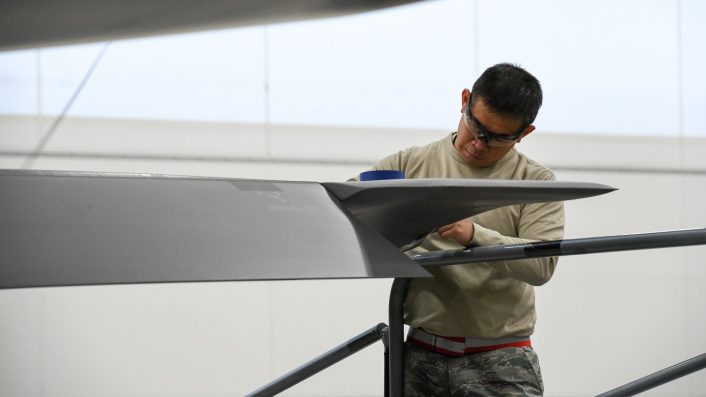
Balancing deployment needs and maintaining stealth features
It must also be noted that maintaining LO (Low Observability) features also often has to be deprioritized over pressing mission and deployment needs, as noted in a heavily redacted Feb. 2024 DOT&E (Director, Operational Test and Evaluation) report. The report also touched upon FMC (Fully Mission Capable) status for F-35A, F-35B and F-35C aircraft.
“During the IOT&E, sortie generation rate (SGR) deployments events, maximization of sortie generation was prioritized over Mission Capable status; consequently, maintenance (such as low observable system restoration) that would have affected the Fully Mission Capable (FMC) status was frequently deferred to allow aircraft to continue to fly sorties,” the report said.
The unidentified period and duration of the OT&E and the specific sorties during when these observations are presumably in the redacted portions, as we mentioned earlier. However, the report adds that “none” of the F-35As and F-35Cs “either achieved or maintained FMC status during any period of these deployments, a condition that would be necessary for combat operations.”
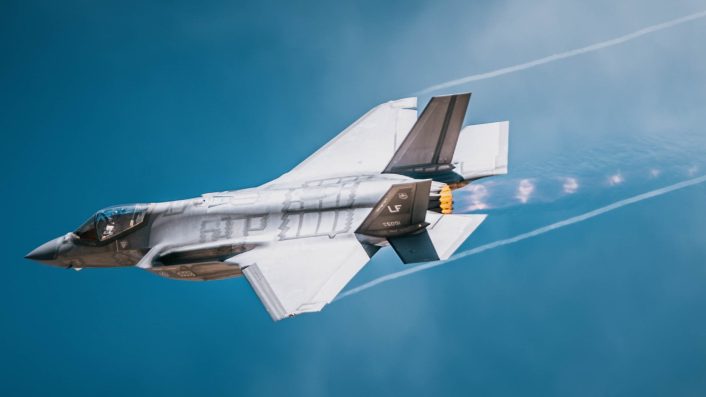
Regarding the STOVL (Short Take-Off and Vertical Landing) F-35B, the “FMC rate was at 20 percent or less for the entire demonstration.” The report also mentions the “LO (Low-Observability) compliance/non-compliance” for the stealth aircraft, saying all F-35A sorties were “LO non-compliant,” while “four out of the five F-35Bs, and 80 percent of individual sorties, were LO non-compliant.” All F-35C aircraft however were reported as LO-compliant.

